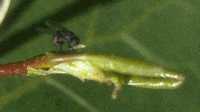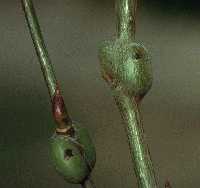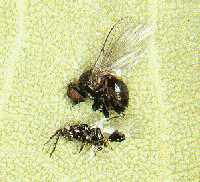by W.S. Cranshaw * (6/13)
Quick Facts…
 |
Figure 1: Galls produced by twiggall fly, with emerging pupae. |
 |
Figure 2: Continued expansion of galls on older wood. |
- Poplar twiggall fly produces a smooth knot-like gall on the twigs of aspen. These galls continue to expand for years after they are produced.
- The poplar twiggall fly is a native insect that has become much more abundant since the early 1980s.
- Several natural controls affect incidence of galling. There are no effective chemical controls to prevent this gall.
The poplar twiggall is an increasingly common gall found throughout Colorado. It develops on the twigs of cottonwoods, poplars and, particularly, aspen. This gall is produced by the feeding of an insect, the poplar twiggall fly (Hexomyza schineri). The galls (Figure 1) are smooth swellings on the current season’s twigs. Obscured by leaves, the original galls are rarely noticed until leaves fall in autumn.
What attracts attention and concern is that galled tissues continue to grow and swell. During subsequent years, the galled area is incorporated into the growing twigs and branches and may ultimately appear as large swollen bands on trunks and branches. Although these old injuries produce a permanent disfigurement, they do not seem to threaten tree health.
Serious galling has been limited to aspen. However, small numbers of galls sometimes can be seen on other Populus species. Galling is most common on younger trees that produce a lot of succulent new growth.
Occasionally Cytospora canker may develop around a gall. The exit wound of the gall-making insect and wounds made by birds removing insects from the galls can be a point of entry for this common fungus disease. (See fact sheet 2.937, Cytospora Canker.) However, the activities of this insect contribute little
to the overall incidence of Cytospora canker.
The poplar twiggall fly is native to the region. Outbreaks began to attract attention in the mid 1980s. Originally, problems seemed limited largely to the southern metro Denver area. However, it has since spread through the state and much of the Rocky Mountain region.
Life History and Habits
The poplar twiggall fly overwinters within the gall as a full-grown, yellow-green maggot. Pupation occurs within the gall in late winter or early spring. The majority of the pupae then drop to the ground.
At the time that new growth forms, the adult flies emerge from the pupae and become active. Adults are stout-bodied, shiny, dark flies about 1/6 inch long. During the day, they rest and sun themselves on leaves. After mating, females move to developing twigs and insert eggs into the stems. The larvae hatch from these eggs and produce the distinctive swelling in response to their feeding.
 |
Figure 3: Adult poplar twiggall fly laying eggs in developing twigs. |
 |
Figure 4: Poplar twiggalls showing
|
 |
Figure 5: Poplar twiggall fly and parasitic wasp. |
Areas below buds appear to be particularly favored sites for galls. As the stems continue to grow, the area where eggs were laid becomes increasingly swollen. At first, the swelling involves a fairly indistinct enlargement. However, within two months the full sized gall is usually present.
The developing gall fly is a greenish-yellow maggot that grows slowly within the gall all summer. It is difficult to find until late summer and fall, when it becomes full-grown, filling a small cavity within the swollen area of the twig. Individual galls typically contain two to three larvae.
Control
There are some natural controls of the poplar twiggall fly. A small parasitic wasp (Eurytoma contractura) parasitizes and commonly kills large numbers of the poplar twiggall fly. Observed parasitism typically ranges from 20 to 30 percent but has exceeded 80 percent in some years. The adult wasps emerge from the galls about two weeks after the adult flies first appear.
Predation of the pupae by chickadees and other birds also occurs in spring. Their activity is evident by some tearing around the exit hole by the beaks of the feeding birds.
Removal of galls is commonly considered by homeowners. However, this has limited potential for control. Pruning often requires substantial branch destruction and creates wounds that can allow pathogens to enter. Furthermore, this practice can be counter-productive if it is done after flies emerge in late winter. Late pruning may remove only those galls that contain the natural enemies of the poplar twiggall fly, the most important being the parasitic wasp mentioned above.
Because problems with poplar twiggall fly are most severe in succulent aspen, do not overwater or fertilize plantings. If aspen growth can be moderated, then gall production can be slowed.
Insecticides applied as sprays have worked poorly to control this insect. However, soil applications of the systemic insecticide imidacloprid have provided good control in nursery settings. The insecticide should be applied as a drench to the soil over the root zone of the tree just prior to or at bud break. (If mulches are present they should be raked away prior to
application to expose the soil during application.) The treated area must be watered so that it remains moist for at least two weeks to allow adequate uptake by the roots.
* Colorado State University Extension entomologist and professor, bioagricultural sciences and pest management. 12/97. Revised 6/13.
Colorado State University, U.S. Department of Agriculture and Colorado counties cooperating. Extension programs are available to all without discrimination. No endorsement of products mentioned is intended nor is criticism implied of products not mentioned.
Go to top of this page.





